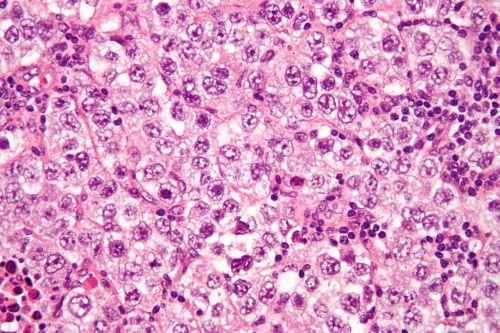15 februari 2016: Bron: American Society of Clinical Oncology
Dat chemo soms wel werkt toont deze studie bij teelbalkanker - zaadbalkanker (of ook wel kiemcelkanker genoemd). Wanneer iemand de diagnose teelbalkanker krijgt en de aangetaste zaadbal wordt operatief verwijderd (gebeurt bijna altijd om de goede diagnose te kunnen stellen) en daarna chemo krijgt met o.a. cisplatin dan is dat meestal een curatieve - genezende behandeling. Zelfs als er al uitzaaiingen zijn. Dit blijkt uit een langjarige studie bij 942 mannen met al of niet uitgezaaide teelbalkanker en behandeld verdeeld over 5 verschillende ziekenhuizen in de periode 1990 t/m 2012.
De 2-jaars ziektevrije overleving was mediaan 98%. En meestal blijkt de genezing dan ook voort te duren in de jaren daarna.
Zoals de onderzoekers ook schrijven:
“Onze data suggereren dat het concept van "conditional" overleving voldoet voor patiënten met uitgezaaide teelbalkanker behandeld met een curatieve aanpak. Patiënten met uitgezaaide teelbalkanker die 2 jaar overleefden hadden in de daaropvolgende jaren een uitstekende kwaliteit van leven en grote kans ziektevrij te blijven, ongeacht de initiële IGCCCG risico stratificatie bij aanvang van de behandeling.” Dius ook patienten die in eerste instantie weinig kans hadden op overleving volgens de IGCCCG risico stratificatie meting.
Foto: microscopisch beeld van een kiemceltumor, bron Wikipedia
De in intentie genezende behandeling bestaat uit operatie, daarna soms bestralen, maar altijd gevolgd door chemo. Op deze engelstalige website staat uitvoerig beschreven hoe teelbalkanker te behandelen enz. Waarin ook wordt gewaarschuwd dat de dosering van de chemo tamelijk nauw luistert om onnodige bijwerkingen te voorkomen door overbehandeling.
Op de website van stichting zaadbalkanker staat ook in het Nederlands informatie hoe zaadbalkanker - teelbalkanker te behandelen, maar lang niet zo uitgebreid.
Het volledige studierapport: Conditional Survival of Patients With Metastatic Testicular Germ Cell Tumors Treated With First-Line Curative Therapy is tegen betaling in te zien.
Hier het abstract van de studie:
High Conditional Survival for Patients With Metastatic Testicular Germ Cell Tumors Receiving First-Line Curative Therapy
- © 2016 by American Society of Clinical Oncology
Conditional Survival of Patients With Metastatic Testicular Germ Cell Tumors Treated With First-Line Curative Therapy
- Jenny J. Ko,
- Brandon Bernard,
- Ben Tran,
- Haocheng Li,
- Tehmina Asif,
- Igor Stukalin,
- Margaret Lee,
- Daphne Day,
- Nimira Alimohamed,
- Christopher J. Sweeney,
- Philippe L. Bedard and
- Daniel Y.C. Heng⇑
+ Author Affiliations
- Corresponding author: Daniel Y.C. Heng, MD, MPH, Tom Baker Cancer Center, Alberta Health Services Cancer Care, University of Calgary, 1331 29th St NW, Calgary, Alberta, T2N 4N2 Canada; e-mail: daniel.heng@albertahealthservices.ca.
-
Presented in part orally at the Genitourinary Cancers Symposium, San Francisco, CA, January 7-9, 2016.
Abstract
Purpose The International Germ Cell Cancer Collaborative Group (IGCCCG) criteria prognosticate survival outcomes in metastatic testicular germ cell tumor (MT-GCT), but how the initial risk changes over time for those who survived since curative treatment is unknown.
Patients and Methods We assessed patients eligible for first-line therapy for MT-GCT at five tertiary cancer centers from 1990 to 2012 for 2-year conditional overall survival (COS) and conditional disease-free survival (CDFS), defined as the probability of surviving, or surviving and being disease free, respectively, for an additional 2 years at a given time point since the initial diagnosis.
Results For all patients (N = 942), 2-year COS increased from 92% (95% CI, 91% to 94%) at 0 months to 98% (95% CI, 97% to 99%), and 2-year CDFS increased from 83% (95% CI, 81% to 86%) at baseline to 98% (95% CI, 97% to 99%) at 24 months after diagnosis. Two-year COS improved by 2% (97% at 0 months, 99% at 24 months) in the IGCCCG favorable-risk group, by 5% (94% at 0 months, 99% at 24 months) in the intermediate-risk group, and by 22% (71% at 0 months to 93% at 24 months) in the poor-risk group. Two-year CDFS improved significantly at 12 months for each risk group (favorable, 91% baseline v 95% at 12 months; intermediate, 84% v 95%; poor, 55% v 85%). Baseline IGCCCG risk stratification was not associated with long-term COS or CDFS for patients who survived to greater than 2 years post therapy. No significant differences in COS and CDFS were noted between seminoma and nonseminoma; patients ≥ 40 years old had inferior 2-year COS from 0 to 12 months, but no differences were noted at 18 months.
Conclusion Our data suggest that the concept of conditional survival applies to patients with MT-GCT treated with curative therapy. Patients with MT-GCT who survived and remained disease free more than 2 years after the diagnosis had an excellent chance of staying alive and disease free in additional subsequent years, regardless of the initial IGCCCG risk stratification.
Footnotes
Authors' disclosures of potential conflicts of interest are found in the article online at www.jco.org. Author contributions are found at the end of this article
Gerelateerde artikelen
- ASCO GU 2025 Genitourinary Cancers Symposium: overzicht van gepresenteerde abstracten gerelateerd aan prostaatkanker, peniskanker, nierkanker en zaadbalkanker copy 3
- Waaraan moet een ziekenhuis voldoen om zaadbalkanker - testiskanker te mogen behandelen? Zie hier de SONCOS normen
- Primaire retroperitoneale lymfeklierdissectie (RPLND) voorkomt dat patienten met niet-feminomateuze kiemceltumoren chemotherapie nodig hebben.
- Overzicht van behandelingen bij testiskanker - teelbalkanker en de rol van biomarkers in het bloed als prognose op aanslaan van de behandelingen en kans op overall overleving
- Zaadbalkanker - teelbalkanker, ook als het is uitgezaaid, is in principe te genezen met operatie plus chemo. Na 2 jaar was 98% nog kankervrij in leven
- Overzicht van de behandelmogelijkheden bij teelbalkanker - germ-cell tumors
- Chemotherapie bij teelbalkanker - germ-cell tumors - blijkt effectief, 90% overal overleving na 5 jaar en 90% ziektevrije tijd na 5 jaar, blijkt uit nieuwe gerandomiseerde langjarige studie.




Plaats een reactie ...
Reageer op "Zaadbalkanker - teelbalkanker, ook als het is uitgezaaid, is in principe te genezen met operatie plus chemo. Na 2 jaar was 98% nog kankervrij in leven"